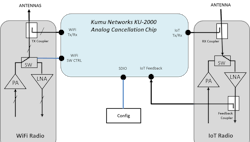Interference caused by Wi-Fi, Bluetooth, Zigbee, and other occupants of the unlicensed 2.4-GHz band is worsening as more wireless users enter the fray. Yet there are ways to mitigate such interference. Here’s one way.
Background
The smart-home industry has come a long way since the first home-automation products were introduced in the late 1970s. Approximately $30 billion worth of smart-home products will ship in 2018, and industry analysts predict global sales will exceed $100 billion by the early 2020s. Wireless security systems, smart appliances (particularly smart TVs), and whole-home Wi-Fi networks are all on the rise.
Unfortunately, interference is a ticking time bomb for smart homes. The typical smart home consists of diverse applications served by different wireless standards. Wi-Fi delivers the high speeds needed to stream video and access the Internet. Zigbee is a good choice for connecting small battery-powered sensors and switches scattered throughout the home. Smart appliances can often be configured via smartphone apps using Bluetooth.
All of these devices compete for access to the same spectrum—the 2.4-GHz ISM band. When relatively few such devices are operating in the home, everything works fine. As more devices are added, interference problems begin to crop up. The well-equipped smart home of the future could suffer from a combination of reduced throughput, longer response times, and shorter battery life.
Smart homes rely on unlicensed wireless services that were created by the FCC in the mid-1980s. At that time, unlicensed devices primarily had to share spectrum with narrowband users and products that created RF for non-communication purposes (such as microwave ovens), so spread-spectrum technology was an excellent choice. Today, literally billions of unlicensed devices are in use. While spread-spectrum devices can share spectrum with each other under carefully controlled conditions (such as in a CDMA network), they’re otherwise just as likely to interfere with each other as non-spread spectrum devices.
Can anything be done to alleviate interference in smart homes? Yes, because it turns out that interference is most problematic in smart-home hubs and “tri-band” Wi-Fi routers—devices that contain two radios. Fortunately, it’s possible to reduce and even eliminate interference in these devices by using self-interference cancellation (SIC) technology. Let’s take a closer look at two leading use cases.
Smart-Home Hubs
Though the typical smart home serves diverse applications, most consumers want centralized management and control. It should be possible to view the status of all smart-home devices on a smart TV or give commands for any devices in the home via a smart speaker.
Key to centralized management and control are smart-home hubs. These units typically contain two or more radios to ensure they can communicate with devices regardless of which wireless standard they use.
However, the Zigbee radio in a smart-home hub can’t hear Zigbee devices while the Wi-Fi radio in the hub is transmitting. Nor do the closest Zigbee nodes have any way of knowing when the hubs’ Wi-Fi radio is going to transmit. As a result, Zigbee messages may be retransmitted over and over.
Zigbee devices are designed to run on the same battery for up to seven years, but that assumes only occasional retransmissions are necessary. That also means door and window sensors, which are much more likely to use Zigbee than Wi-Fi, have to wait for the Wi-Fi radio to stop transmitting in order to get a message through indicating a door or window has been opened.
Using SIC, the Wi-Fi radio’s transmit signal can be cancelled out at the input of the Zigbee radio’s receiver, and the Zigbee radio’s transmit signal can be cancelled out at the input of the Wi-Fi radio’s receiver. This allows both the Wi-Fi and Zigbee radios in the smart-home hub to transmit and receive at the exact same time. (Currently, the radios must take turns transmitting, but that doesn’t enable the idle radio to receive transmissions from external devices, because its receiver is desensitized by other radios’ transmit signals.)
The SIC solution consists of a mixed-signal design built around an RFIC. The figure illustrates how SIC can be implemented in a smart-home hub with two radios. (The IoT radio in our example is Zigbee-based, but it could just as easily be based on 6LoWPAN or some other low-speed, wireless personal-area-network standard.)
This dual-radio smart-home hub is equipped with self-interference cancellation.
SIC neutralizes the interfering signal by generating a cancellation signal and applying it at the input of the receiver. The cancellation signal is produced by directly sampling the output of the transmitter and continuously monitoring the environment for reflections. The canceller uses a series of “taps” consisting of attenuators, phase shifters, and delay lines to generate a precision cancellation signal.
Whole-Home Wi-Fi Networks
Consumers increasingly desire whole-home Wi-Fi coverage to reach PCs and Internet-connected TVs in different rooms, and to avoid using up their mobile data gigabytes whenever possible. There are now a number of whole-home Wi-Fi products on the market based on the 802.11s mesh-networking standard.
Not all Wi-Fi mesh products are created equal, though. 802.11s is an amendment to the 802.11 MAC standard and doesn’t specify the physical medium. Many Wi-Fi mesh products use the same channels that provide access to client devices to send traffic between the mesh nodes. This approach works, but it’s like doubling the number of active client devices—it reduces the throughput available to end users by 50%.
Better performance is provided by Wi-Fi mesh nodes equipped with two 5-GHz radios—so-called “tri-band routers.” These routers have three radios: one 5-GHz radio for communicating with 5-GHz client devices, one 5-GHz radio for relaying traffic between nodes, and a 2.4-GHz radio for communicating with older clients that don’t support 5-GHz operation.
The advantage of such an arrangement is that it provides one dedicated 802.11ac channel for client device access and another for traffic between nodes. Given the rapid increase in internet access speeds and the development of ultra-HD television and virtual-reality broadcasting, whole-home Wi-Fi networks based on tri-band routers are better prepared for the future.
However, tri-band routers face a couple of challenges. First, in order to operate two radios in the same band at the same time, most of the routers use the pair of 80-MHz channels that are at opposite ends of the band. This practically guarantees that any neighboring networks are using the same channels, greatly increasing the likelihood of interference between networks. And relying on one pair of channels also limits the flexibility of the mesh network within the home. In some cases, the best coverage and capacity can be achieved by using different backhaul channels in different parts of the home.
Second, the two radios are normally isolated from each other using a pair of filters: a low-pass filter on the lower channel and a high-pass filter on the higher channel. Filters must be inserted in the signal path to block unwanted frequencies; thus, they often incur some loss on desired frequencies as well.
SIC technology can be used in combination with filters to enable tri-band routers to use any pair of the six 80-MHz channels allocated in the 5-GHz band. And because SIC is based on a different operating principle—it creates a pinpoint cancellation signal rather than blocks a range of frequencies—it doesn’t add loss to the desired signal.
SIC offers one more advantage for Wi-Fi mesh nodes: It enables the design of smaller, more elegant units. The use of SIC and a diplexer makes it possible for two 5-GHz radios to share the same antennas. And because SIC provides electronic isolation between MIMO chains, there’s less need to rely on physical separation for isolation.
Conclusion
The smart home is taking off largely because the industry has a choice of wireless standards. There are wireless solutions optimized for sensors and wireless solutions optimized for high definition video.
Ensuring that dozens or even hundreds of wireless devices in a single home can operate efficiently and effectively is a challenge. However, the wireless industry has a history of turning challenges into opportunities. A technology that empowers wireless devices to operate despite strong interference is exactly what’s needed to take spectrum sharing to the next level.
Joel Brand is the VP of Product Management for Kumu Networks.
About the Author
Joel Brand
VP of Product Management
For over 25 years, Joel has actively participated in defining and building infrastructure solutions for the telecom and wireless industries. He previously held executive positions at ConteXtream (acquired by HP), Bytemobile (acquired by Citrix), and Ruckus Wireless (NYSE: RKUS and now part of Arris). Joel holds a B.Sc. and M.Sc. in Engineering from the Israeli Institute of Technology (the Technion) as well as an MBA from National University in San Diego.


